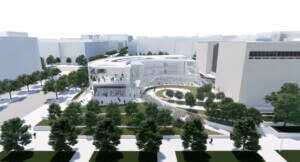As cities across the country struggle to bring new life to aging athenaeums and cash-strapped local libraries, the AIA has honored six outstanding examples of library design in this year’s AIA/ALA Library Building Awards. In the past we have seen a Walmart transformed into a library, a controversial starchitect renovation in New York, and an interactive, LED light-show—now take a look at these honored projects. From democratic design in the nation’s capital to a stunning Beaux-Arts restoration in St. Louis and high-tech solutions in North Carolina, this year’s winning projects present a range of answers to the challenges facing our fading repositories.
The jury for the biannual award included Jeanne M. Jackson, FAIA, Chair, VCBO Architecture; John R. Dale, FAIA, Harley Ellis Devereaux; Charles Forrest, Emory University Libraries; Kathleen Imhoff, Library Consultant; J. Stuart Pettitt, AIA, Straub Pettitt Yaste and John F. Szabo, Los Angeles Public Library.
Anacostia Neighborhood Library
Washington, D.C.
The Freelon Group
From the AIA: The small-scale residential context provided the inspiration for the design of this new branch library, located in a low-income, underserved neighborhood in Washington, D.C. The project not only fulfilled programmatic needs but also provided a stimulus for community pride and economic development.
The residential scale is reflected in the library design as a series of pavilions for program areas that require enclosure: the children’s program room, the young adults’ area, support spaces, and public meeting rooms. The remainder of the level one plan is high, open space for the main reading room, stacks, computers, and public seating areas. A large green roof structure provides shelter over all program areas.
Central Library Renovation
St. Louis
Cannon Design
From the AIA: Cass Gilbert’s grand Beaux-Arts library, now 100 years old and a St. Louis cultural landmark, was in need of a transformative restoration that would increase public access and modernize it for the 21st century.
On the interior, the centrally located Great Hall is surrounded by five wings, four dedicated to public reading rooms and the fifth, the north wing, to a multistory book depository closed to the public. The transformation of the north wing truly rejuvenated the library and brought it into the next century. Old book stacks were removed, and a new “building within a building” was inserted. Now, a multistory public atrium provides an accessible and welcoming entry. The new “floating platforms” surround the atrium without touching existing interior walls. Glass-enclosed upper levels house the collection with compact high-density bookshelves. The windows of the north wall, now clear glass, bounce natural light deep into the interior and provide striking views.
New York Public Library, Hamilton Grange Teen Center
New York City
Rice + Libpka Architects
From the AIA: The center, located on the previously empty third-floor space of Harlem’s Hamilton Grange branch library, designed by McKim, Mead and White, is NYPL’s first full-floor space dedicated to teens. In an effort to attract and engage neighborhood youth, the 4,400-square-foot space challenges the norms of library design. The light-filled floor is divided into specific zones that foster small-group interaction and socialization. Visibility is maintained across the entire floor.
Two programmatic elements—a 20-foot-diameter Media Vitrine and a bamboo bleacher—occupy the center of the space and work to define the seven zones between and around them. The vitrine’s open-top glass enclosure upends the notion that multimedia spaces must be dark, hyperisolated rooms. The bleacher allows views out to the street from the existing high south-facing windows and provides a sunny hang-out for a range of group sizes. Custom L-shaped lounge benches bracket this space and can be rolled away to allow for other uses and activities.
James B. Hunt Library
Raleigh, North Carolina
Snøhetta and Pear Brinkley Cease + Lee
From the AIA: An $11 million reduction in the budget for this library during the schematic design phase prompted the design, construction, and client teams to formulate a range of new ideas to maintain functionality and quality. The building would need to be highly programmed and reasonably versatile as well as comfortable and stimulating to visitors.
One innovation was the introduction of an automated book delivery system (ABDS), which effectively reduced the total area of the building by 200,000 gross square feet and allowed more space for collaboration and technology. The ABDS is supported by user-friendly browsing software that matches and even enhances the traditional pleasure of browsing a collection.
Oak Forest Neighborhood Library
Houston
NAAA + AWI + JRA
From the AIA: This 7,600-square-foot modern brick and glass structure opened in 1961. Fifty years later, there was still great nostalgia for the library’s mid-century modern design, but the building no longer met the standards of the Houston Public Library system or the needs of the surrounding neighborhood. The 2011 renovations and additions respect the character of the existing library and enhance its accessibility and functionality.
The original building’s restored signature green tile mosaic still graces the parking entry area on the north, but now the neighborhood is welcomed by a tree-shaded second entry and outdoor reading room framed by new dedicated adult and teen areas on the west. The original tile mosaic and globe light canopy of the old circulation desk were restored to create a toddler-sized reading nook. Each age group—from toddlers through teens and adults—now has appropriate facilities, furnishings, and technology. A new lobby and circulation space, lit by a continuous shaded clerestory, occupies the seam between old and new and unites the two entries.
South Mountain Community Library
Phoenix
richärd+brauer
From the AIA: The building integrates the varied uses of a contemporary public library with the needs of a state-of-the-art central campus library, allowing each to function both independently and collaboratively. The design is modeled after that of an integrated circuit, providing insulation between disparate functions and promoting interaction and connection between like functions and spaces.
The simple massing of the building is attenuated to focus views on the surrounding mountains and provide shade and transparency. The site was once home to fertile agricultural valleys and citrus groves, and the building consciously merges interior and exterior spaces to connect to the area’s rich history. A series of rooftop monitors and light shafts flood natural light into the first-level core. The rain screen, formed of bent planks of copper, calls to mind the pattern of an abstracted bar code. Variegated cedar strips reinforce the digital aesthetic of the building. Further echoing the design of a circuit board, building systems are organized and expressed within an internally lit independent distribution soffit.










